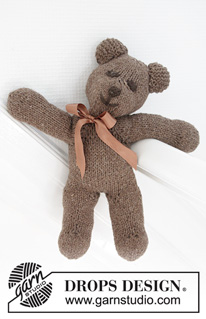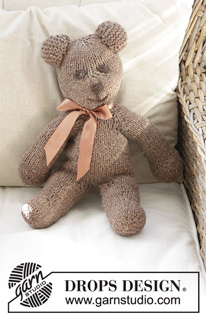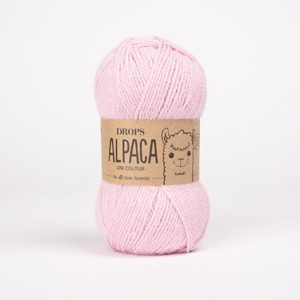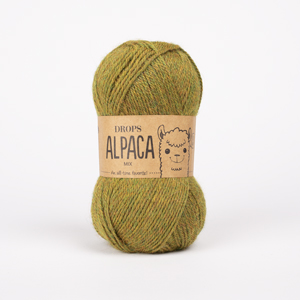Comments / Questions (48)
![]() Jannyhilhorst wrote:
Jannyhilhorst wrote:
Kan ik dit patroon krijgen Janny hilhorst
30.05.2025 - 15:37DROPS Design answered:
Dag Janny,
Al onze patronen zijn gratis af te drukken het print pictogram rechts boven bij het patroon. Klik op het print pictogram en dan op 'Patroon afdrukken'.
01.06.2025 - 10:24
![]() Janny Hilhorst wrote:
Janny Hilhorst wrote:
Kan ik dit patroon gratis krijgen. \r\nJanny Hilhorst
30.05.2025 - 15:35
![]() Sigrun wrote:
Sigrun wrote:
Hei. Finnes det en video som forklarer hvordan men strikker de to bena sammen?
10.03.2025 - 17:39
![]() Sigrun wrote:
Sigrun wrote:
Hei Jeg skal strikke sammen de 2 beina. Finnes det en video av hvordan dette gjøres?
10.03.2025 - 14:32DROPS Design answered:
Hej Sigrun, du har det ene ben på pinden, slår 2 masker op, sætter det andet ben ind på pinden og slår 2 masker op, nu strikker du rundt :)
14.03.2025 - 11:57
![]() Trude Merete Aasbø wrote:
Trude Merete Aasbø wrote:
På armene står det at du skal følge oppskriften til bena opp tom pinne 16, blir det ikke da 28 masker og ikke 21?
24.11.2024 - 19:22DROPS Design answered:
Hei Trude Merete, Etter omgang 16 (på beina og armene) skal du ha 21 masker, siden du avslutter omgang 12 med 21 masker og de neste 4 omganger er bare glattstrikk. God fornøyelse!
25.11.2024 - 07:07
![]() Joanne Humphries wrote:
Joanne Humphries wrote:
What does “use 3 threads of alpaca” mean?
12.06.2024 - 12:37DROPS Design answered:
Dear Mrs Humphries, this means you work with 1 strand from 3 different balls = 3 strands DROPS Alpaca (not only 1). Happy knitting !
12.06.2024 - 16:31
![]() Sonja Villiger wrote:
Sonja Villiger wrote:
Frage ❓ich habe ein bein gestrickt ist das richtig ,der oberschenkel befindet dich hinten zum fuss. Beinabnehmen 3 maschen in mitte bein.
27.04.2023 - 19:11DROPS Design answered:
Liebe Frau Villiger, die Runden beginnen immer an der gleichen Stelle, dh wenn man die Abketten Runde strickt sind die stillgelegten 6 Maschen die ersten von den 20 Maschen zu stricken, die 2 letzten maschen der Runde sind vor den 6 Maschen, die stillgelegt waren = vordere Mitte. Beim nächsten Bein stricken Sie die 8 ersten Maschen (= die stillgelegten 6 Maschen + die 2 nächsten). Viel Spaß beim stricken!
28.04.2023 - 11:40
![]() Zuzana wrote:
Zuzana wrote:
Veľmi milý návod, dobre sa podľa neho pracovalo. Ja som plietla zo zvyškov DROPS Safran, spletala som rôznofarebné priadze, tiež to vyzerá dobre.
22.09.2022 - 07:55
![]() Paty Fdez Soto wrote:
Paty Fdez Soto wrote:
Me gusta mucho, pero si hubiera un vídeo mejor , sería excelente
04.05.2022 - 20:51
![]() Joanne RICHARDS wrote:
Joanne RICHARDS wrote:
How many balls of Drops alpaca are required for this pattern please?
19.01.2022 - 01:07DROPS Design answered:
Hi Joanne, Drops Alpaca comes in balls of 50 g, so you need 4 balls for this teddy bear. Happy knitting!
19.01.2022 - 07:58
Mister Bean#dropsmisterbean |
|
 |
 |
Teddy knitted in “Alpaca”.
DROPS Baby 11-28 |
|
|
Knitting gauge: 16 sts x 21 rows on needles size 5 mm / US 8 with 3 strands of Alpaca in stockinette sts = 10 x 10 cm / 4" x 4". Inc. tips: Inc as follows: Make a yo, on the returning row twist and knit the yo to avoid a hole. Teddy: The teddy is knitted with 3 strands of Alpaca. Make the legs first, then the body and arms and finally the head and then the ears. Legs: Cast on 9 sts on needle size 5 mm / US 8 with 3 strands of Alpaca and distribute sts evenly on 3 needles. Insert a marker at the beg of round. Round 1-6: Knit in stockinette sts, inc 3 sts evenly on each round – see Inc. tips above = 27 sts. Round 7-11: Knit in stockinette sts. Round 12: *Slip a st as if to knit, K2 tog psso* , repeat 3 times, knit the remaining 18 sts in stockinette sts = 21 sts in total. Round 13-16: Knit in stockinette sts Round 17: K2, inc. 1 st, K19 = 22 sts. Round 18-19: Knit in stockinette sts Round 20: K2, inc. 1 st, K20 = 23 sts. Round 21-22: Knit in stockinette sts. Round 23: K3, inc. 1 st, K21 = 24 sts. Continue in stockinette sts until the piece measures 12 cm / 4¾". Now bind off for the thigh as follows: K6 sts and put them on a holder (= the middle of the leg). Put the remaining sts on 1 needle and finish the leg in stockinette sts back and forth on needle as follows: Knit until 1 st left and turn. Slip a st as if to knit and continue until 1 st left, turn, slip a st as if to knit and continue until 2 sts left, turn, slip a st as if to knit and continue until 2 sts left, turn, slip a st as if to knit and continue until 3 sts left, turn, slip a st as if to knit and continue until 3 sts left, turn slip a st as if to knit and K all sts. There are still 24 sts remaining incl the 6 sts from the holder. Put the sts from the holder back on the needle and distribute the sts over 3 needles, knit 1 round of stockinette sts but to make sure the 3 sts each side of the 6 sts from the holder become tight enough, knit them as follows: Pick 1 st up from previous round and K this one tog with the st on the needle (this means the sts are knitted double) – repeat for all 3 sts each side. Knit 1 round as follows: K20, bind off 2 sts (= the inside of the leg), K2 = 22 sts. Pull the opening tog at the bottom of the foot. Put the piece aside and knit the other leg, but knit the last round as follows: K8, bind off 2 sts (= the inside of the leg), K14 = 22 sts. Body: Put both legs tog on the 3 needles, at the same time cast on 2 new sts in between the legs at the front and at the back = 48 sts. Distribute the sts so the beg of the round will be at the mid back of the teddy (it is a good idea to insert a marker). Measure from here onwards! Round 1-2: Stockinette sts Round 3: K 14, K2 tog, K16, K2 tog, K14. Round 4: K 14, K2 tog, K14, K2 tog, K14 = 44 sts Continue in stockinette sts until the piece measures 9 cm / 3½". Next round: K6, K2 tog, K2 tog, K2, K2 tog, K2 tog, K2 tog, K8, K2 tog, K2 tog, K2 tog, K2, K2 tog, K2 tog, K6 = 34 sts Next round: K2, K2 tog, K2 tog, K1, bind off 4 sts ( "armhole"), K1, K2 tog, K6, K2 tog, K1, bind off 4 sts (= "armhole"), K1, K2 tog, K2 tog, K2, then K the first 5 sts on round to the "armhole". This leaves 10 sts for the back and 10 sts for the front, continue to knit each piece separately. Back piece: Knit in stockinette sts, at the same time K the first 2 sts and then the last 2 sts tog (seen from the RS), repeat the dec on every other row until 4 sts left. Put these sts on a holder. Front piece: Knit as the back piece. Right Arm: Cast on and knit as the leg until round 16. Continue in stockinette sts over all sts until the piece measures 12 cm/4¾". Next round: K6, bind off 2 sts (= mid under arm), K 13 sts. Continue back and forth on needle. K the the first 2 sts and then the last 2 sts tog (seen from the RS) on every row from RS until 5 sts left. Put the sts on a holder. Pull the opening tog at the bottom of the arm with the casting on thread, sew tight. Left Arm: Cast on and knit as right arm until the piece measures 12 cm/4¾". Next round: K16, bind off 2 stitches for underarm, K3 sts. Continue and finish as right arm. Head: Put the remaining sts from the back piece, arm, front piece and arm (= 18sts) on the 3 needles as follows: Distribute the sts so the round begins mid back (it is a good idea to insert a marker). Round 1: Stockinette sts Round 2: Inc 6 sts evenly distributed on round = 24 sts Round 3-6: Inc 3 sts evenly distributed on each round. Round 7-8: Inc 9 sts evenly distributed on each round = 54 sts. Continue in stockinette sts until the piece measures 7 cm / 2¾" Next round: K21 sts, *slip a st as if to knit, K2 tog, psso*, repeat from *-* a total of 4 times, K21 sts = 46 sts Next round: K21 sts, slip a st as if to knit, K1, psso, slip a st as if to knit, K1, psso, K21 sts = 44 sts. Next round: *K2, K2 tog*, repeat from *-* a total of 4 times, K12, *K2 tog, K2*, repeat from *-* a total of 4 times = 36 sts Next round: K7, K3 sts and then put them on a safety pin (= sts for the ear), K16 , K3 sts and then put them on a safety pin (= sts for the ear) K7. On the following round pick up 1 st behind each st from the safety pin (sts are now both on the safety pin and the needle). Knit in stockinette sts until the piece measures approx. 14 cm / 5½". K 2 tog around = 18 sts. K 2 tog around one more time, cut the yarn and pull through the remaining 9 sts. Ear: Pick up 3 sts from one safety pin. Knit the ear in garter sts throughout (= knit all rows). Row 1: K1, make a yo, K1, make a yo, K1 = 5 sts Row 2: K the 5 sts Row 3: K1, *make a yo, K1*, repeat from *-* until finish = 9 sts. Row 4: K the 9 sts. Row 5: K1, *make a yo, K1*, repeat from *-* until finish = 17 sts. Continue to knit in garter sts until the ear measures approx. 6 cm / 2⅜". Next row: *K all sts tog 2 by 2 and finish with K1, K all sts on the returning row*, repeat from *-* 3 times = 3 sts left on row. Bind off. Fill the ear with poly stuffing and sew it tight. Repeat for the other safety pin. Assembly: Fill the teddy with poly stuffing through the hole underneath the arm. Sew the opening in between the legs. Sew the eyes, the snout and the mouth with a remainder of darker brown or black. Sew the arms onto the body, pull the arms down so they will be sewn to the body approx 4 rounds underneath the first casting/binding off for the "armhole" (this is done to give the teddy a bit of stomach). |
|
Have you finished this pattern?Tag your pictures with #dropspattern #dropsmisterbean or submit them to the #dropsfan gallery. Do you need help with this pattern?You'll find 19 tutorial videos, a Comments/Questions area and more by visiting the pattern on garnstudio.com. © 1982-2025 DROPS Design A/S. We reserve all rights. This document, including all its sub-sections, has copyrights. Read more about what you can do with our patterns at the bottom of each pattern on our site. |
|




































































Post a comment to pattern DROPS Baby 11-28
We would love to hear what you have to say about this pattern!
If you want to leave a question, please make sure you select the correct category in the form below, to speed up the answering process. Required fields are marked *.